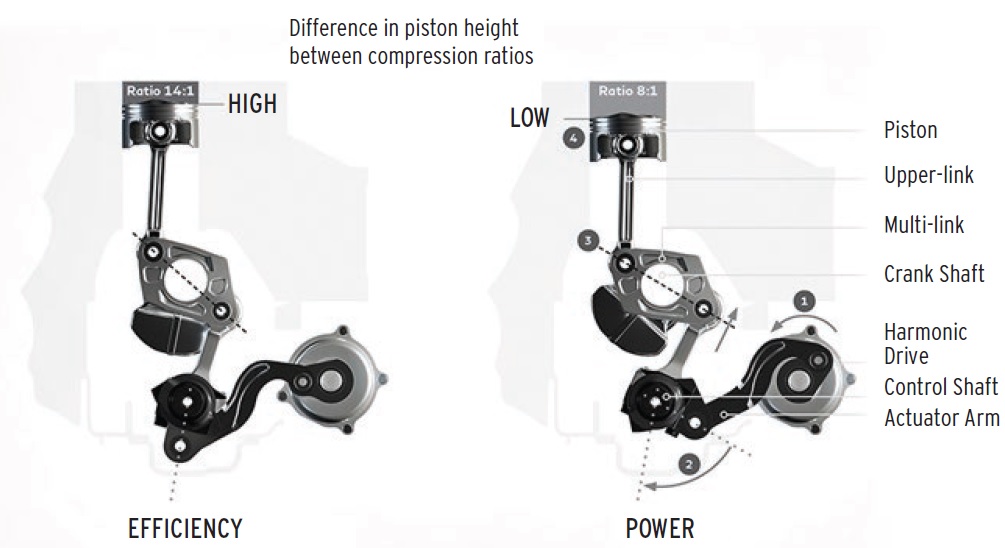Have we finally achieved variable compression ratio?
Dr. Edward P. Becker | TLT Automotive Tribology February 2018
Nissan says it will begin offering the new technology in model year 2018 vehicles.
A FUNDAMENTAL CHOICE when designing a gasoline (or other spark-ignited fuel) engine is the compression ratio; that is, the ratio of the maximum to minimum cylinder volume during the piston stroke. One of the first immutable facts one learns about engines is higher compression ratio equals higher efficiency. So our first thought is to maximize compression ratio.
Unfortunately there are many practical limits to maximizing compression ratio. The higher the compression ratio, the higher the maximum pressure in the cylinder, and therefore the more robust (i.e., heavy) the cylinder components become. Also, as the gas in the cylinder is compressed, temperature rises. While this works well for a diesel (or compression-ignition) engine, it is a major problem for the spark-ignited engine. If the fuel-air mixture begins to combust spontaneously, a number of related (and undesirable) phenomena can result, such as detonation, knock, pre-ignition and, ultimately, engine failure. For these and other reasons, the choice of compression ratio for a gasoline engine has been limited to relatively low values.
Until now, that is. Infiniti (the luxury arm of Nissan motor company) announced it will begin offering an engine with a variable compression ratio, beginning in model year 2018. The basic components of the system are shown in Figure 1, and Nissan has released a video (
1) showing an animation of the system. Dubbed the VC-Turbo, Nissan claims a one-mile-per-gallon fuel economy gain and a one-second improvement in 0-60 mile per hour performance. This is accomplished by using the high compression ratio when the engine is operating at part load (thereby increasing efficiency) and the lower compression ratio at full load (thereby improving power output).
 Figure 1. Infiniti variable compression ratio mechanism.
Figure 1. Infiniti variable compression ratio mechanism.
Clearly the system adds weight to the engine, but Nissan claims the added efficiency more than compensates. The additional mechanical complexity and number of moving parts are of interest to the engine tribologist. Note that the standard piston-rod assembly has two slider-bearing surfaces, the big end of the rod (where the motion is full-rotation unidirectional sliding) and the small end (with partial rotation, fully reversed sliding). In the VC-Turbo system there are an additional five partial rotations, fully reversed sliding bearing surfaces! Two of these only move during actuation of the VC system, with the other three in constant motion.
The system is located inside the crankcase, so a continuous supply of engine oil is readily available. Apparently the added friction from these bushing surfaces is manageable, and Nissan further claims that piston side forces are reduced, resulting in a net decrease in engine friction.
Whether Nissan’s innovation will spark (pun intended) the competition to implement its own variable compression ratio schemes remains to be seen. In any case, this is yet another example of the evolution of the internal combustion engine.
REFERENCE
1.
Available
here.
 Ed Becker is an STLE Fellow and past president. He is president of Friction & Wear Solutions, LLC, in Brighton, Mich., and can be reached through his website at www.frictionandwearsolutions.com
Ed Becker is an STLE Fellow and past president. He is president of Friction & Wear Solutions, LLC, in Brighton, Mich., and can be reached through his website at www.frictionandwearsolutions.com.